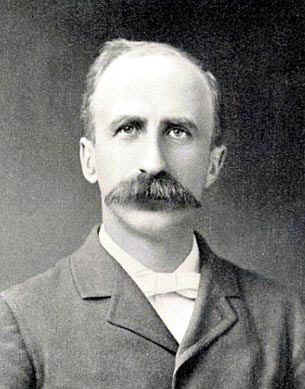Views
Hollis, Queens
View Larger Map
History of Hollis

| Frederick W. Dunton [1] |
|---|
The neighborhood of Hollis, Queens was originally purchased in 1656, as part of the purchase of Jamaica by the Dutch from the Jameco Indians. [2] The Dutch coaxed a group of colonists from Hempstead to homestead in the Beaver Pond area. (Beaver Pond was filled in 1906 [3] ) For the next century, the section now called Hollis was known as East Jamaica, a farm area between Jamaica and Queens Village. The area consisted of about 20 farms, and until the American Revolution, there was little development there. [4]
Hollis is the brainchild of Frederick W. Dunton, who was the last Supervisor of the Town of Jamaica. [5] Dunton had planned to name Hollis Woodhull, in honor of the general who had been captured there by the British in 1776 at what is now 197th Street and Jamaica Avenue. However, Dunton wanted to avoid confusion with another Woodhull in Steuben County, and so he named it after his birthplace in New Hampshire instead. [6] From 1884 to 1885 the area was developed by Frederick W. Dunton, formerly a Queens Highway commissioner. [7] He and his backers bought two farms in 1885 and laid out the village of Hollis. [8] Dunton purchased 136 acres of land and got his friends to take up an interest in the area. He made a profit by selling them land lots, which they used to build houses. After Dunton sold off the land, homes began to spring up in the area. [9]
A railroad station was opened in Hollis in 1885, after Dunton and a few others donated land so that it could be built. [10] This station later on became a part of the Long Island Railroad. [11] In May 1897 trolley service was extended in Hollis. This attracted developers of upper-middle-class houses: Hollis Park Gardens was built between 192nd and 195th streets between Jamaica and Hillside avenues in 1906, and over the next twenty years, many similar developments were added. [12]
There were 130 houses within a half-mile of the railroad station by 1910, and most of these houses were Victorian-style. There were also a few surviving farmhouses. Hollis Park Gardens began building high-class houses in 1906. This development, which stretched from 191st to 195th Street, catered to affluent families. [13] The population had grown to nearly 4,000 residents by 1920, and because of its location, Hollis attracted a large number of people who commuted to Manhattan to work. [14] Carpenter’s Tavern, the place where General Woodhull was captured, was replaced by housing in 1921. The neighborhood continued to grow as stately Victorian houses were built along Woodhull Avenue between 188th and 198th streets. [15] Starting in 1922 many new streets were laid out between Hillside and Jamaica Avenues and tract houses were built by the hundreds. Hollis had become a fully built up community by World War II. [16]
From the time the neighborhood was established until after World War II, the neighborhood was inhabited mainly by white Irish and Italian immigrants and their descendants. The ethnic composition changed south of the railroad after 1955. By 1980 the population was 80 percent black and Latin American. The neighborhood attracted immigrants from Guyana, Haiti, China, India, and Colombia during the next decade. By the mid 1990s Hollis was a middle-class community of well-kept, one-family houses, and had fewer than half a dozen high-rise apartment buildings. [17] Currently, the population of Hollis is about 31,000 residents. [18] To this day Hollis has retained its residential suburban quality, although many of the houses that were built when Hollis was founded are no longer standing. [19]
From 1884 to 1885 the area was developed by Frederick W. Dunton, formerly a Queens Highway commissioner. He named Hollis after Hollis, New Hampshire, his birthplace. Dunton purchased 136 acres of land and got his friends to take up an interest in the area. He made a profit by selling land to them, which they used to build houses.
- Currently in Hollis
- Economic Decline in Hollis
- Interesting Facts about Hollis
- Conclusions about Hollis
References
- ↑ "History." 24 Apr. 2009 <http://www.hollisny.com/history.htm>.
- ↑ Queens Library "Community and Library History." Queens Library. 18 Apr. 2009 <http://www.queenslibrary.org/index.aspx?page_nm=CL-Communityinfo&branch_id=HO>.
- ↑ Encyclopedia of New York City. New Haven, Conn: Yale UP, New-York Historical Society, 1995.
- ↑ "Hollis: Kid on the Block Got Back on Tract." OrlandoSentinel.com. 18 Apr. 2009 <http://www.orlandosentinel.com/topic/ny-historytown-hist000g,0,1730495.story>.
- ↑ Seyfried, Vincent F. Old Queens, N.Y., in early photographs. New York: Dover Publications, 1991.
- ↑ Encyclopedia of New York City. New Haven, Conn: Yale UP, New-York Historical Society, 1995.
- ↑ Queens Library "Community and Library History." Queens Library. 18 Apr. 2009 <http://www.queenslibrary.org/index.aspx?page_nm=CL-Communityinfo&branch_id=HO>.
- ↑ Seyfried, Vincent F. Old Queens, N.Y., in early photographs. New York: Dover Publications, 1991.
- ↑ Queens Library "Community and Library History." Queens Library. 18 Apr. 2009 <http://www.queenslibrary.org/index.aspx?page_nm=CL-Communityinfo&branch_id=HO>.
- ↑ Queens Library "Community and Library History." Queens Library. 18 Apr. 2009 <http://www.queenslibrary.org/index.aspx?page_nm=CL-Communityinfo&branch_id=HO>.
- ↑ "Hollis Court Malls: Hollis Court Blvd, Jamaica to Hillside Aves." New York City Department of Parks & Recreation. 18 Apr. 2009 <http://www.nycgovparks.org/parks/QZ40/>.
- ↑ Encyclopedia of New York City. New Haven, Conn: Yale UP, New-York Historical Society, 1995.
- ↑ Seyfried, Vincent F. Old Queens, N.Y., in early photographs. New York: Dover Publications, 1991.
- ↑ Queens Library "Community and Library History." Queens Library. 18 Apr. 2009 <http://www.queenslibrary.org/index.aspx?page_nm=CL-Communityinfo&branch_id=HO>.
- ↑ Encyclopedia of New York City. New Haven, Conn: Yale UP, New-York Historical Society, 1995.
- ↑ Seyfried, Vincent F. Old Queens, N.Y., in early photographs. New York: Dover Publications, 1991.
- ↑ Encyclopedia of New York City. New Haven, Conn: Yale UP, New-York Historical Society, 1995.
- ↑ Queens Library "Community and Library History." Queens Library. 18 Apr. 2009 <http://www.queenslibrary.org/index.aspx?page_nm=CL-Communityinfo&branch_id=HO>.
- ↑ Seyfried, Vincent F. Old Queens, N.Y., in early photographs. New York: Dover Publications, 1991.